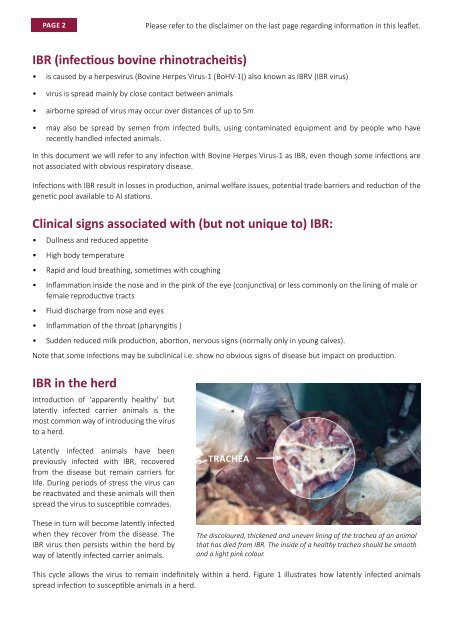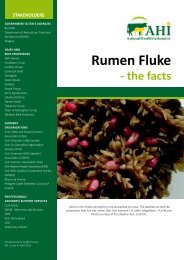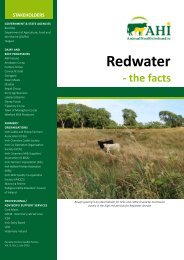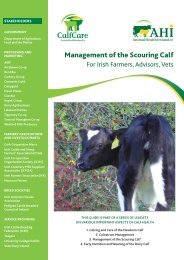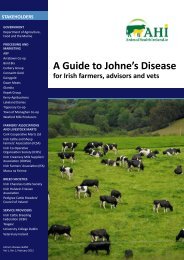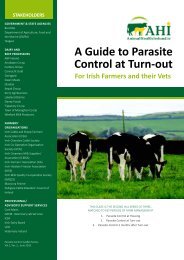IBR - an information leaflet for Irish Farmers - Animal Health Ireland
IBR - an information leaflet for Irish Farmers - Animal Health Ireland
IBR - an information leaflet for Irish Farmers - Animal Health Ireland
Create successful ePaper yourself
Turn your PDF publications into a flip-book with our unique Google optimized e-Paper software.
Page 2<br />
Please refer to the disclaimer on the last page regarding <strong>in<strong>for</strong>mation</strong> in this <strong>leaflet</strong>.<br />
<strong>IBR</strong> (infectious bovine rhinotracheitis)<br />
• is caused by a herpesvirus (Bovine Herpes Virus-1 (BoHV-1)) also known as <strong>IBR</strong>V (<strong>IBR</strong> virus)<br />
• virus is spread mainly by close contact between <strong>an</strong>imals<br />
• airborne spread of virus may occur over dist<strong>an</strong>ces of up to 5m<br />
• may also be spread by semen from infected bulls, using contaminated equipment <strong>an</strong>d by people who have<br />
recently h<strong>an</strong>dled infected <strong>an</strong>imals.<br />
In this document we will refer to <strong>an</strong>y infection with Bovine Herpes Virus-1 as <strong>IBR</strong>, even though some infections are<br />
not associated with obvious respiratory disease.<br />
Infections with <strong>IBR</strong> result in losses in production, <strong>an</strong>imal welfare issues, potential trade barriers <strong>an</strong>d reduction of the<br />
genetic pool available to AI stations.<br />
Clinical signs associated with (but not unique to) <strong>IBR</strong>:<br />
• Dullness <strong>an</strong>d reduced appetite<br />
• High body temperature<br />
• Rapid <strong>an</strong>d loud breathing, sometimes with coughing<br />
• Inflammation inside the nose <strong>an</strong>d in the pink of the eye (conjunctiva) or less commonly on the lining of male or<br />
female reproductive tracts<br />
• Fluid discharge from nose <strong>an</strong>d eyes<br />
• Inflammation of the throat (pharyngitis )<br />
• Sudden reduced milk production, abortion, nervous signs (normally only in young calves).<br />
Note that some infections may be subclinical i.e. show no obvious signs of disease but impact on production.<br />
<strong>IBR</strong> in the herd<br />
Introduction of ‘apparently healthy’ but<br />
latently infected carrier <strong>an</strong>imals is the<br />
most common way of introducing the virus<br />
to a herd.<br />
Latently infected <strong>an</strong>imals have been<br />
previously infected with <strong>IBR</strong>, recovered<br />
from the disease but remain carriers <strong>for</strong><br />
life. During periods of stress the virus c<strong>an</strong><br />
be reactivated <strong>an</strong>d these <strong>an</strong>imals will then<br />
spread the virus to susceptible comrades.<br />
These in turn will become latently infected<br />
when they recover from the disease. The<br />
<strong>IBR</strong> virus then persists within the herd by<br />
way of latently infected carrier <strong>an</strong>imals.<br />
trachea<br />
The discoloured, thickened <strong>an</strong>d uneven lining of the trachea of <strong>an</strong> <strong>an</strong>imal<br />
that has died from <strong>IBR</strong>. The inside of a healthy trachea should be smooth<br />
<strong>an</strong>d a light pink colour.<br />
This cycle allows the virus to remain indefinitely within a herd. Figure 1 illustrates how latently infected <strong>an</strong>imals<br />
spread infection to susceptible <strong>an</strong>imals in a herd.


